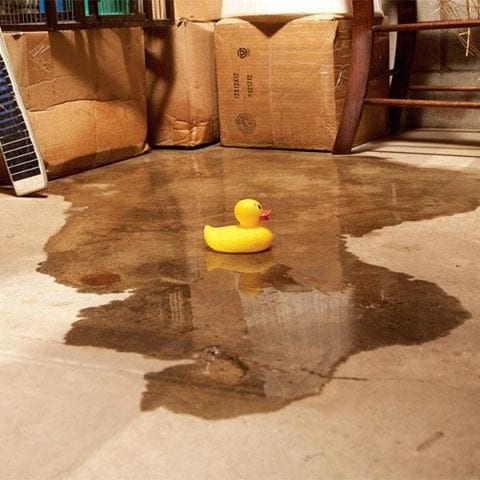
26 Feb Leaking Basement Waterproofing Repair & Specialist Leak Sealing Solutions
What can we do to keep your basement and car park dry and prevent moisture from making its way in?
Water leaking into the basement after heavy rain is a common occurrence. Water always finds a way by following the path of least resistance, so basement waterproofing and adequate drainage are especially needed in cases where groundwater is likely to build up in the soil and the water table to rise closer to the surface.
There are many ways water can enter a basement or below-grade structure. Water can intrude through the foundation slab, retaining walls, basement windows, cracks, and pipe penetrations.
In Brisbane and Sydney areas, we often see that buildings that are cut into a hillside stand a greater risk of having the “hillside side” affected by hydrostatic pressure if adequate steps to redirect the water are not taken. Poor drainage can cause water to collect against the concrete foundation and retaining walls during heavy and persistent rain events, and when building up in volume it and can cause problems attributable to lateral and hydrostatic pressure (water pressure from the soil). Steps that are taken to direct water flow away from basements/foundations eliminate pooling and help reduce the chances of water building up around the building.
Water ingress in basements is commonly experienced during heavy rain due to the rising water table bringing the groundwater closer to the surface. This increases the hydrostatic pressure onto the slab of your building and can force water to pass through cracks in the concrete and/or the construction joint between the floor and the wall, otherwise known as the cove joint or floor to wall joint. This joint effectively begins working as a highway passage for water into your basement.
The floor to wall joint – especially when it is an infill slab where the slab is poured between existing walls – can be extremely vulnerable to water intrusion/seepage. Water can leak in through the floor to wall joint even with an intact positive side waterproofing where the waterproofing system has been installed to the soil facing side of the subsurface building components, as illustrated in the image below.
Please note that for a concrete slab to be impacted by hydrostatic pressure, it must be below the water table or intrude into a natural water pathway. Interestingly, the water table level can be altered by adjacent construction, so a basement that used to be dry can now be at risk of water intrusion.
Basement leakage points. Common places water may enter into your basement or other areas of your property that are subterranean.
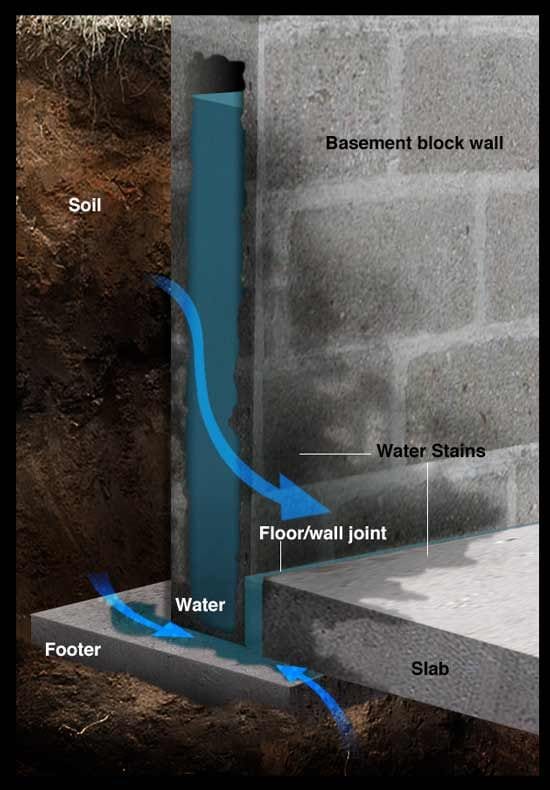
How water gets into your basement.
How to keep water away from the basement structure:
- Inspect the walls and floors. If cracks appear, repair or seal them immediately. Water has a way of finding a small entryway and then making it bigger over time.
- Install gutters and downspouts away from the foundation.
- Ensure that the ground has a graded fall that guides water away from the foundation.
- A drainage layer of gravel eliminates trapping water-laden soil against foundation walls.
- Drains below slabs that direct water to a natural exit.
- Ensure that the interior basement waterproofing is intact to prevent water ingress. Wall to floor joints in infill slabs and retaining walls often act as basement leakage points. This can cost-effectively be remediated with targeted high-pressure leak sealing injection into the joints and cracks to create a deep and flexible waterproof seal. This treatment can be followed by the application of a protective coating or a reverse/negative side membrane.
A leaking concrete structure can cause a ripple effect on other building assets
Water seeping through concrete dissolves minerals such as calcium hydroxide, which is extremely corrosive to galvanised steel. In the photo below, you can see that the water that has been seeping through the concrete was dripping onto the air duct causing it to rust and break apart. Additional factors that corrode galvanised steel and reinforcement in concrete are high humidity and sodium chloride (salt) in water or air.
The durability of concrete structures is under constant threat from carbonation and crack causing movements, which can lead to water ingress affecting the durability of the concrete structure. Regular inspections and preventative maintenance are crucial to help protect assets from deterioration, thus extending the lifetime of your asset investment. Issues like cracks in concrete, water seepage and spalling affect the integrity and longevity of the asset, so they are best to remediate at an early stage to help decrease the expenses of extensive remedial repairs.
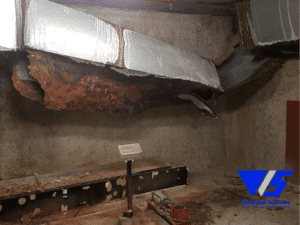
Water seeping through concrete dissolves minerals such as calcium hydroxide, which is extremely corrosive to galvanised steel – causing the air duct to rust.
Concrete crack injection and concrete leak sealing repair of basements and underground car parks
At Waterstop Solutions, we specialise in leak sealing injections and interior basement waterproofing systems
A wet basement can be treated by targeted high-pressure injection into the wall-floor joint and/or into vertical joints, such as between contiguous piles. The injected hydrophilic polyurethane liquid chases the water deep into cracks and forms a flexible watertight seal. This remedial waterproofing treatment can be followed by the application of a waterborne epoxy coating or a negative side waterproof membrane.
The waterproofing membrane systems we use create an effective barrier against waterborne salts. They are also resistant to atmospheric gases and comply with potable water safety standards.
The systems are supported by the manufacturer’s warranty for 10 years, which is extendable to a further 10 years with a maintenance application.
Our highly-skilled technicians frequently perform remedial high-pressure leak-sealing injections to stop water seeping into building structures. Whilst other remedial companies may average once a year (or at most once a month), our technicians perform quality high-pressure leak-sealing injection work several times per week.
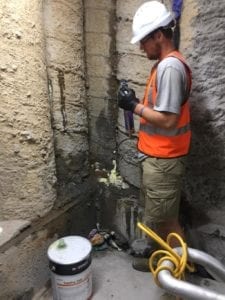
Basement car park – vertical concrete joint injection of polyurethane to waterproof the leaking cracks in contiguous piles.
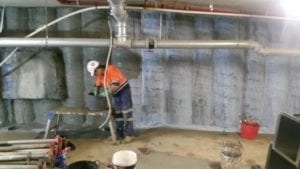
Waterproofing Repair. Installation of reverse side cementitious waterproof membrane. Below Ground Car Park in Brisbane.
Are you interested in finding out more about the various remedial building services we are providing?
Please click on the image below to download Waterstop Solutions Capability Statement
Waterstop Solutions Capability Statement is now available to download as PDF. (The image is clickable and opens up a link to our Capability Statement).
Good maintenance begins with a proactive approach to maintain, keep, preserve and protect a building.
Remember that seepage/water ingress into areas such as basements, concrete roofs, car parks and retaining walls, should not be ignored – call a remedial waterproofing professional today for an assessment to provide you with the best solution for your situation.
At Waterstop Solutions, we carry out a wide range of remedial works to concrete structures post construction stage.
Equipped with major civil works experience, we can quickly determine the best approach to rectify all seepage and concrete deterioration issues.


